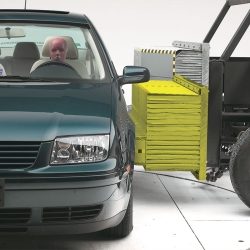
The IIHS tests the crashworthiness of a motor vehicle using five crash tests. One of those crash tests works to determine the safety of a vehicle in the event of a side crash, or t-bone accident. These types of crashes are the cause of approximately a quarter of deaths in passenger vehicles in the U.S. Offering protection to passengers in t-bone and side crashes is more challenging than in front and rear crashes because of the lack of crumple zones. There is fairly little space for energy to be absorbed and occupants shielded.
In the IIHS side crash test, a moving deformable barrier is used to strike the tested vehicle at 50 KM per hour, or 31 MPH. The barrier weighs about 3,300 pounds and is used to represent the height and front-end geometry of a pickup truck or SUV. These are the types of vehicles that cause a lot of damage to other vehicles when they collide in real-world t-bone crashes. Two test dummies are placed in the test vehicle: one in the driver position and another in the left rear position. These dummies represent a small female and an adolescent. Injury measures are collected from these dummies from the head, neck, chest, pelvis, and lower extremity regions in hopes of identifying the total injury risks to the occupant in this crash. Besides injury measures, one of the things that is looked at is how good a job the side air bags do at protecting the passengers’ heads from outside intruding objects, like the hood of a high riding vehicle or a tree, pole, or post. The test also looks at how good a job the occupant compartment does at holding up and resisting intrusion. This is done by measuring the safety cage: how much it intrudes before and after the crash.
Motor vehicle production has come a long way since the Institute’s first release of side impact crash test results in 2003. Back then, most vehicles had safety cages that allowed too much intrusion into the compartment and side airbags were not standard safety features. When you look at vehicles on roadways today, most vehicle’s safety cages are very strong, limit intrusion into the compartment, and the side airbags do a really nice job of protecting the vital organ areas. As a result, we have a vehicle fleet that is much safer and does a much better job of protecting occupants in severe side crashes.
Categories: Auto Accidents, Car Accident, Personal Injury




